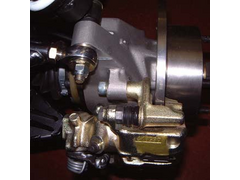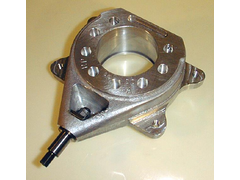aj
|
| posted on 18/1/05 at 11:39 PM |

|
|
ball joint - aluminum upright
Does anyone know if a ball joint can be attached directly to aluminum?
I'm building a custom rear upright from billet aluminum.
Cast alloy uprights on production cars alway seem to have a taperd steel insert where the ball joint attaches. Is this necessary?
Thanks
|
|
|
|
|
Liam
|
| posted on 19/1/05 at 12:05 AM |

|
|
Well a ball joint will potentially wear an ally taper much quicker than a steel one, especially if it becomes the slightest bit loose. Bear in mind
suspension parts on production cars are designed to be safe after 10+ years of poor maintenance on a heavy car.
I can't really see how an ally taper could wear unless the ball joint is loose and can impact or abrade the surface of the taper. Perhaps the
problem is that the normal loading can locally yield and distort the soft material and allow this to happen. I would have thought an ally taper would
be perfectly fine if it's looked after properly and the joint is kept tight, especially on a light, well maintained car. But i'm not
reeeeally qualified to say.
Liam
|
|
|
Rorty
|
| posted on 19/1/05 at 04:09 AM |

|
|
I've used tapered studs in aluminium. It worked fine, though I can't say difinitively how long it would last, as I changed the entire
setup after a while.
It should work OK, as long as it's done sensibly.
Cheers, Rorty.
"Faster than a speeding Pullet".
PLEASE DON'T U2U ME IF YOU WANT A QUICK RESPONSE. TRY EMAILING ME INSTEAD!
|
|
|
britishtrident
|
| posted on 19/1/05 at 08:00 AM |

|
|
The taper won't wear unless it loose however aluminium alloys have no definite yeild pont so you will get stress relaxation (aka low temperature
creep) that wil slacken the hold of the taper --- in simple terms the hole will get slightly bigger long period of over time.
However ---
On the rear If its for road use you shouldn't need to ues a ball joint simple metalastic or polly bushes are all you need --- for track use
use rose joints.
|
|
|
aj
|
| posted on 19/1/05 at 06:40 PM |

|
|
So I guess it would work but no long term guarantee.
britishtrident you said 'for track use use rose joints' This brings up another question ...
Is there any way to safely use a rose joint on the top rear upright connection?i.e. rear upper outer a-arm.
It seems like the twisting force of braking would stress a rose joint. I know this has probably been discused before but I can't seem to find an
exact answer.
great forum by the way
|
|
|
Rorty
|
| posted on 19/1/05 at 08:52 PM |

|
|
quote:
Originally posted by aj
So I guess it would work but no long term guarantee.
britishtrident you said 'for track use use rose joints' This brings up another question ...
Is there any way to safely use a rose joint on the top rear upright connection?i.e. rear upper outer a-arm.
It seems like the twisting force of braking would stress a rose joint. I know this has probably been discused before but I can't seem to find an
exact answer.
great forum by the way
Rose joints are frequently used for wishbone to upright connections. You could bolt through the aluminium like in the pic below, or if
you're bolting into aluminium, then insert a Helicoil first
 
Rescued attachment cast_upright2.jpg
Cheers, Rorty.
"Faster than a speeding Pullet".
PLEASE DON'T U2U ME IF YOU WANT A QUICK RESPONSE. TRY EMAILING ME INSTEAD!
|
|
|
Rorty
|
| posted on 19/1/05 at 08:53 PM |

|
|
Another bolt through example.
 
Rescued attachment cast_upright3.jpg
Cheers, Rorty.
"Faster than a speeding Pullet".
PLEASE DON'T U2U ME IF YOU WANT A QUICK RESPONSE. TRY EMAILING ME INSTEAD!
|
|
|
aj
|
| posted on 19/1/05 at 11:36 PM |

|
|
What's a Helicoil???
Also, my rear suspension has one coilover shock mounted to a pivot bar, which passes through the bottom of the upright and the lower a-arm. The shock
is about 5 inches from the hub/wheel centerline(toward the rear). I don't know anything about suspension forces but it seems like, with the
shock this far away, that the upright is going to want to twist toward the rear. If this is true most of that force is going to be on the upper
upright connection. Does this make any sense?
|
|
|
Rorty
|
| posted on 19/1/05 at 11:57 PM |

|
|
quote:
Originally posted by aj
What's a Helicoil???
Also, my rear suspension has one coilover shock mounted to a pivot bar, which passes through the bottom of the upright and the lower a-arm. The shock
is about 5 inches from the hub/wheel centerline(toward the rear). I don't know anything about suspension forces but it seems like, with the
shock this far away, that the upright is going to want to twist toward the rear. If this is true most of that force is going to be on the upper
upright connection. Does this make any sense?
Helicoils are thread inserts for repairing damaged female threads or for making strong threads in soft materials.
Helicoil how to.
It sounds like your lower shock mount is in single shear and quite a distance from any support. If so, it's not ideal, but withought seeing it,
it's difficult to comment precisely.
Cheers, Rorty.
"Faster than a speeding Pullet".
PLEASE DON'T U2U ME IF YOU WANT A QUICK RESPONSE. TRY EMAILING ME INSTEAD!
|
|
|
Liam
|
| posted on 20/1/05 at 12:03 AM |

|
|
Helicoils are great. Essentially a steel (stainless i think) coil that you wind into a thead, which then itself becomes the thread for your bolt. If
that makes sense!
For example, you drill and tap a hole bigger than you need for your bolt, wind the helicoil in, then put your bolt in. It means you can have a steel
thread in your ally part and so reduce significantly the chances of stripping or otherwise damaging that thread. We use them at work in any ally part
that needs a thread.
You can also use them to repair stripped internal threads since you drill out your stripped thread larger than it was, tap it, then insert the
helicoil. Ta daa.
At work we just have loads of them in boxes, but I think the home user can buy kits of them which will include the correct drill and tap, as well as a
load of helicoils. They really do kick arse, especially when you think you've wrecked a threded ally part!
Liam
|
|
|
Liam
|
| posted on 20/1/05 at 12:04 AM |

|
|
Er - like rorty said, whilst I was writing!!
[Edited on 20/1/05 by Liam]
|
|
|













